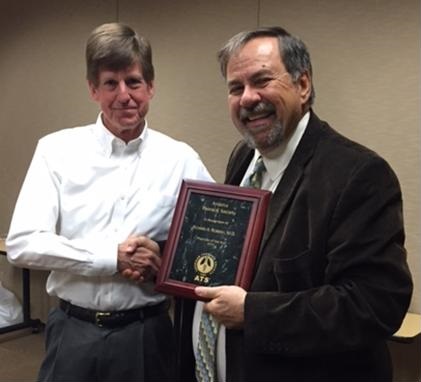The July 2016 Arizona Thoracic Society meeting was held on Wednesday, July 27, 2016 at the Scottsdale Shea Hospital beginning at 6:30 PM. This was a dinner meeting with case presentations. There were 14 in attendance representing the pulmonary, critical care, sleep, and radiology communities.
Prior to the case presentations, a discussion was held on 4 issues. First, Dr. Rick Robbins gave a summary of ATS Hill Day. During Hill Day a presentation was given by a representative from the Campaign for Tobacco-Free Kids. Their web site lists tobacco company contributions to members of Congress on their web site. Dr. Gary Ewart from the ATS office in Washington gave a presentation on the Traditional Cigar Manufacturing and Small Business Jobs Preservation Act before Congress (aka the Cigar Bill) which the ATS opposes. He noted that cosponsors for the bill included several Congressmen from Southwestern states. Dr. Robbins combined the two sets of data to see if there was a correlation between the tobacco company contributions and cosponsorship of the Cigar Bill. There was a highly significant correlation and Dr. Robbins asked the group if they felt this data was worthy of publication in the SWJPCC. The consensus was that Dr. Robbins should write an article and send it out for review.
Second, the Arizona Hospital Executive Compensation Act 2016 was discussed. This is an Arizona state proposition to limit hospital executive pay to $450,000/year which was circulated by Service Employees International Union and submitted to the Arizona Secretary of State to include on the November ballot. Although the required number of signatures were present, the validity of those signatures is being challenged by Arizona Chamber of Commerce. The Arizona Hospital and Healthcare Association said a cap on executive pay would "harm healthcare and hurt patients.“ Dr. Robbins asked if a survey through the SWJPCC should be conducted to determine whether the act would harm patients. After discussion, the Arizona Thoracic Society asked Dr. Robbins to conduct the survey the report on the results.
Third, a discussion was held on Medicare Access and CHIP Reauthorization Act of 2015 (MACRA). The ATS along with other groups has been asked for input for quality measures. However, Rep. Kevin Brady (R-Texas), chairman of the House Ways and Means Committee, was recently quoted by Medpage Today as saying “MACRA is a good law, but I'm frustrated with the implementation…The heart of this [was supposed to be] how do you measure quality? Should we measure it from Washington, or measure the best practice of what is occurring in that region or in those physician practices?” (1). After discussion and noting that many previous quality measures are not evidence based, the Arizona Thoracic Society thought that local input was important. Dr. Robbins is to ATS CCR representatives from the Southwest and to report to a committee consisting of Dr. Wesselius, Parides and Robbins to determine how best to voice the Arizona Thoracic Society's input into determining quality measures.
Lastly, Dr. Parides moved to name Dr. Lewis Wesselius as the Arizona Thoracic Society clinician of the year. This was unanimously approved.
Dr. Lewis Wesselius presented a 52-year-old woman with a past renal transplant for eclampsia and hypertension who presented with a low grade fever 38.2º C and a right upper lobe mass. Her coccidioidomycosis serology was negative. Bronchoscopy with bronchoalveolar lavage was performed but was initially non-diagnostic.
After bronchoscopy, the mass markedly enlarged but the patient refused further diagnostic studies since despite her worsening radiologic appearance, she felt somewhat better. Her Legionella serology subsequently returned positive as did her Legionella culture from her bronchoscopy. She was treated with levofloxacin and markedly improved.
Dr. Gerry Swartzberg presented two cases of positive Gold Quantiferons in an asymptomatic 76 year old woman whose father had tuberculosis and a 35 year drug addict. After discussion, the consensus was not to treat the elderly woman but treat the younger drug addict.
Dr. George Parides again asked for input on bringing more young people into the Arizona Thoracic Society. Several suggestions were given and several members said they would contact the local fellowship directors.
There being no further business, the meeting was adjourned about 8 PM. The next meeting will be in Phoenix on Wednesday, September 28, 2016 at 6:30 PM.
Richard A. Robbins, MD
Editor, SWJPCC
Cite as: Robbins RA. July 2016 Arizona thoracic society notes. Southwest J Pulm Crit Care. 2016;13(1):38-9. doi: http://dx.doi.org/10.13175/swjpcc071-16 PDF
 Tuesday, January 31, 2017 at 4:50PM
Tuesday, January 31, 2017 at 4:50PM 

